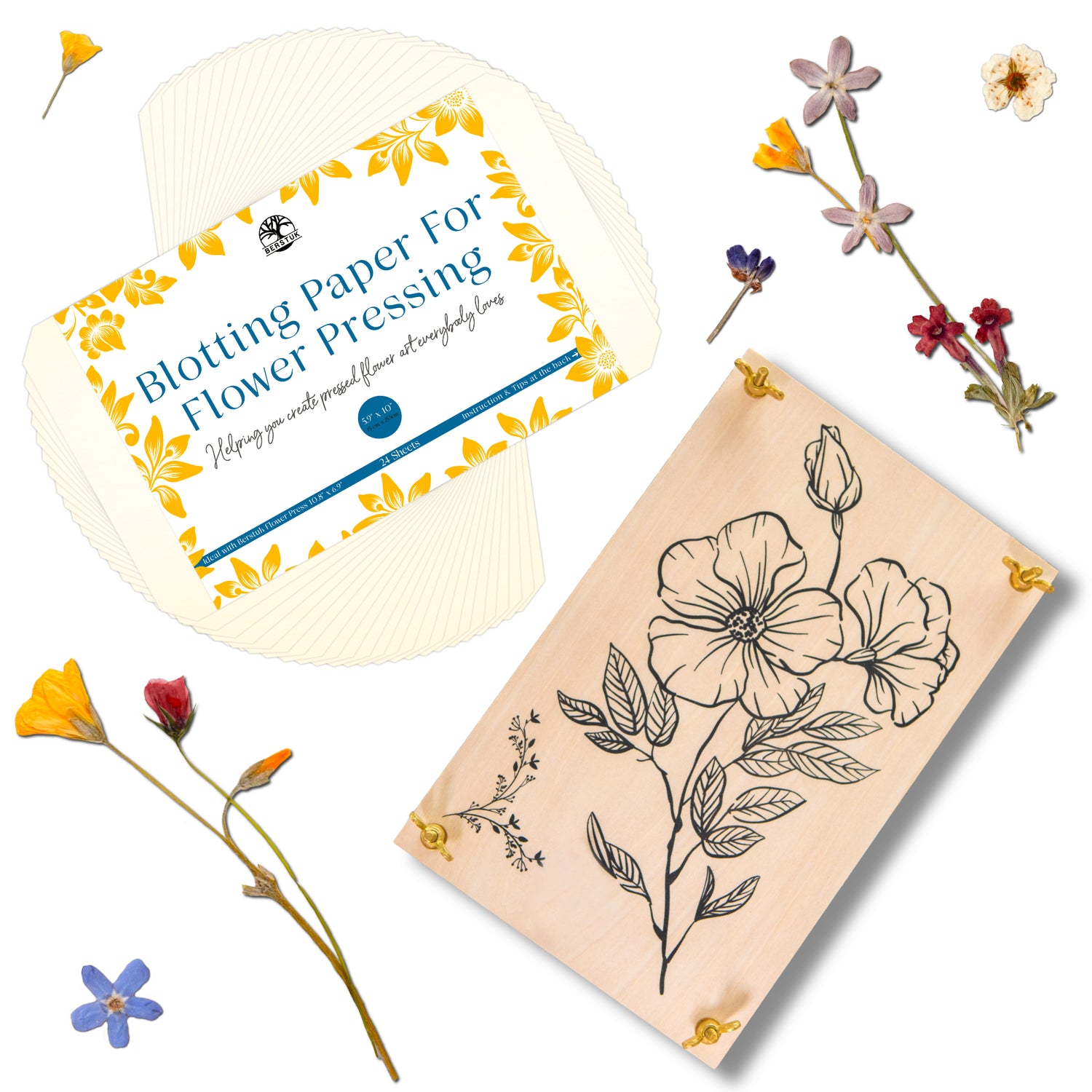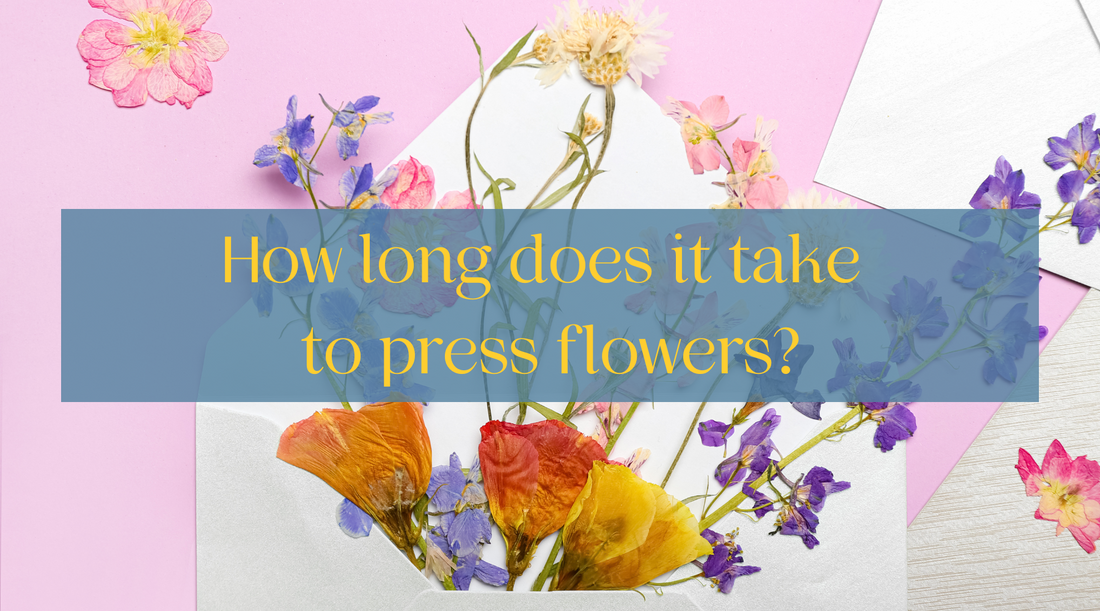When it comes to flower pressing, one of the most common questions is "how long does it take for flowers to press?" The answer to this question can vary depending on a few factors, such as the type of flower, the humidity levels, and the method of pressing you are using.
In this article, we will explore some of the factors that can affect the pressing time and give you an idea of what to expect.
Type of flowers
First, let's talk about the type of flower. Some flowers press more quickly than others. For example, flowers with thinner petals and less moisture, such as pansies or violets, will press more quickly than flowers with thicker petals and more moisture, such as roses or daisies. In general, delicate flowers will press faster than larger, more robust flowers.
You can read more on this topic here, The easiest flowers to press for beginners.
Humidity level
Another factor that can affect the pressing time is the humidity level. High humidity can slow down the pressing process because it can cause the flowers to retain more moisture. This means that if you're pressing flowers in a location with high humidity, it may take longer for them to press than if you were pressing them in a location with low humidity.
Pressing method
The method of pressing also plays a role in the pressing time. If you're using a traditional flower press (i.e. a wooden flower press), it can take anywhere from 2 to 4 weeks for flowers to press fully. However, if you're using a more modern method, such as a microwave press, the pressing time can be significantly shorter, taking only a few minutes.
NB. if you are new to flower pressing and perhaps you don't have your own press yet, check out this super quick guide How to press flowers for preservation - Quick Absolute Beginners Guide.
It's important to keep in mind that the pressing time can vary depending on the type of flower, humidity levels, and the method of pressing. The best way to know when your flowers are fully pressed is to check on them periodically and see if they are flattened and dry. The drying process can take from 2 to 3 weeks, but it can take more or less time depending on the circumstances.
Whole blooms vs single petals
When you press a whole flower, the petals and layers of the flower have to be separated, dried and flattened evenly, which can take a lot of time and effort. However, when you press each petal separately, the process is much faster. The petals are already separated, so you don't have to worry about separating them yourself (+ plus they're already being pressed and in contact with blotting paper).
Pressing flowers petal by petal may sound like a tedious task, but it can actually save you time in the long run. Pressing whole flowers may seem like the quicker option, but at the same time it can take weeks for the flowers to fully dry and flatten out.
On the other hand, pressing petals individually can take a bit more time upfront, but the end result is usually worth it as the petals will be flattened and ready to use in a matter of days (this holds true for quite a few flowers, but not all). Plus, pressing petals separately allows for more control over the final product and can give a more delicate and intricate look to your pressed flowers.
If you're short on time or want to get your pressed flowers done quickly, pressing each petal individually is the way to go! So, don't be afraid to take the time to press your flowers petal by petal – it may just be the secret to beautiful, vibrant pressed flowers in a fraction of the time.
If you are thinking to press your flowers separately, that is petal by petal, have a look at our article How to press rose petal by petal (the process is the same for other blooms too).
Little rub down
One thing you can do to speed up the pressing process is to remove as much moisture from the flowers as possible before you press them. This can be done by gently patting them dry with a paper towel or allowing them to air dry for a few hours (before they start wilting).
This will help to reduce the amount of moisture that needs to be removed during the pressing process, thus shortening the pressing time.
If they are already dry on the surface, you can start pressing your blooms right away (the sooner they're being pressed, the better).
Drying hack
Another way to speed up the pressing process is to use a desiccant like silica gel. These are small packets filled with a moisture-absorbing material that can be placed inside the press with the flowers. However, the best type is very fine silica gel (powder) as that does not leave imprints on your blooms (it can get a bit dusty though).
Simply, sprinkle some powder over the paper (not the flowers to avoid imprints). The silica gel can help to absorb any remaining moisture in the flowers and speed up the drying process (plus, further reduce risk of losing your blooms to nasty mold).
Summary
In conclusion, the pressing time for flowers can vary depending on a number of factors, such as the type of flower, humidity levels, and the method of pressing. In general, delicate flowers (single petalled, for example) will press faster than larger, more robust flowers. The humidity level can also affect the pressing time, and the method of pressing plays an important role too.
Pressing flowers whole can take anywhere from 2-4 weeks, depending on the type and size of the flower. Pressing flowers petal by petal, on the other hand, can take as little as a few days. This is because the pressure is applied directly to each individual petal, allowing for quicker and more thorough drying.
The best way to know when your flowers are fully pressed is to check on them periodically, and if you want to speed up the process, you can remove as much moisture from the flowers as possible and use a desiccant like silica gel.
Remember, pressing flowers is not only about the time but also about the care and patience you put into it. Happy flower pressing!
Don't miss out on exclusive flower pressing tips, discounts, and more! Sign up for our mailing list now and join our community of flower enthusiasts who are always one step ahead. Click HERE to perfect your pressed flower art.



